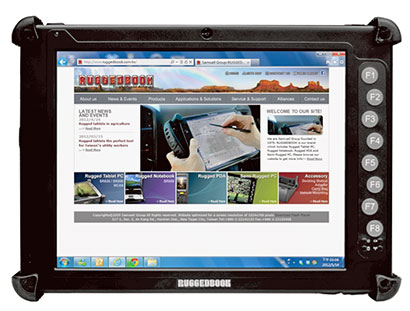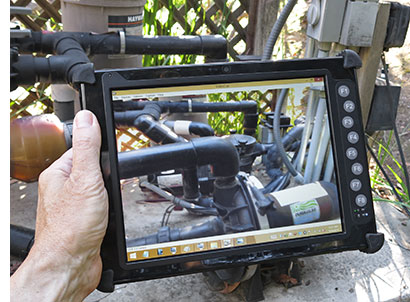When Samwell introduced the PC-750 a couple of years ago, the goal was to present a lighter, handier alternative for situations where a full-size tablet computer was too big and heavy. In essence, the platform was the tablet equivalent of a netbook — smaller, lighter and less expensive than a full-size laptop. Netbooks are long gone, but the PC-750 line remains relevant to the enterprise and vertical markets as a Windows-based, more rugged, and much better connected alternative to consumer media tablets. In response, Samwell introduced first the second generation PC-751, and now the third generation PC-752, both based on Intel's "Bay Trail" processor technology.

What is the Ruggedbook Tablet PC 752, and where does it fit in? At a time where many manufacturers of rugged computing equipment wonder how to stem the allure of standard consumer tablets in a case with something that's just as slick but more durable, the 752 is simply a rugged Tablet PC, nothing more and nothing less. It's over an inch thick (and more with its protective bumpers), and weighs almost three pounds, more than twice as much as a consumer market tablet. This is not a high-tech fashion statement to impress the crowd at Starbucks. It is a rugged tablet tool for jobs out there in the field.
Unlike some of the industrial and enterprise market tablets that have been introduced as of late, the Ruggedbook 752, doesn't seek to be a more protected version of an iPad or a consumer Android tablet. It's more like a modern interpretation of a traditional Tablet PC. It measures 10.8 x 7.8 inches, which is quite compact. Its 10.4-inch is 1st-gen iPad-class and looks large and inviting. And unlike media tablets that must make due with one small micro-USB port, it has a full complement of I/O ports, and they are all full size.
The design is purposeful rather than slick and fancy. No chrome or stylistic elements here, except perhaps part of the front housing that is needlessly glossy. The 752 is just an innocuous-looking tablet with boxy rubber bumpers on each corner to provide additional protection. There is no keypad and there are no hardware controls other than a number of large membrane pushbuttons, labeled F1 through F8, along the right side of the display.
With tablets, more so than with desktops or laptops, display quality is everything. That's because while users generally sit down in front of a notebook or desktop display and look at it head-on, the viewing angle of tablets varies depending on how it's being held. Which means that a display that lets you look at the tablet from any angle without losing image quality and clarity is invaluable (and, in our opinion, pretty much mandatory). The Ruggedbook 752 has such a display. You can look at it from any angle and the image remains perfectly viewable. No color shifts and aberrations, no changes in brightness or contrast. The high viewing quality of this display is especially amazing since resistive touch screens usually make displays less readable.
Unlike the vast majority of media tablets and smartphones that use projected capacitive touch, the Ruggedbook 752 has a conventional resistive touch screen that can be operated with a stylus or finger. That means no effortless panning and pinching and zooming as you can do on capacitive touch screens, but it also means the 752's display can be used in the rain and with gloves on. If a customer does require capactive multi-touch, Samwell offers the 752 with an optional 9.7-inch (same asize as the iPad) with projected capacitive multi-touch.
 The biggest difference between the Ruggedbook 751 and the new 752 is that the latter is powered by an Intel Celeron N2930 processor instead of the 751's Atom E3825. While both of these chips are part of Intel's "Bay Trail" lineup of vastly improved CPUs, the quad-core Celeron N2930 is towards the top end and the Atom E3825 towards the bottom end of the Bay Trail lineup.
The biggest difference between the Ruggedbook 751 and the new 752 is that the latter is powered by an Intel Celeron N2930 processor instead of the 751's Atom E3825. While both of these chips are part of Intel's "Bay Trail" lineup of vastly improved CPUs, the quad-core Celeron N2930 is towards the top end and the Atom E3825 towards the bottom end of the Bay Trail lineup.
Here's a processor comparison between the new Ruggedbook 752, the Ruggedbook 751 and the N2600 in the initial Ruggedbook 750:
|
PROCESSOR COMPARISON
|
Ruggedbook 752
|
Ruggedbook 751
|
Ruggedbook 750
|
|
Intel processor
|
Celeron N2930
|
Atom E3825
|
Atom N2600
|
|
Lithography
|
22 nm
|
22 nm
|
32 nm
|
|
Cores/Threads
|
4/4
|
2/2
|
2/4
|
|
Clock Speed
|
1.83 GHz
|
1.33 GHz
|
1.60 GHz
|
|
Burst/turbo
|
2.16 GHz
|
no burst
|
no burst
|
|
Thermal Design Power (TDP)
|
7.5 watts
|
6.0 watts
|
3.5 watts
|
|
Cache
|
2MB
|
1MB
|
1MB
|
|
Integrated graphics
|
HD Graphics
|
HD Graphics
|
GMA 3600
|
|
Graphics base speed
|
313 MHz
|
533 MHz
|
400 MHz
|
|
Graphics burst speed
|
854 MHz
|
533 MHz
|
400 MHz
|
|
Hyperthreading
|
No
|
No
|
Yes
|
|
Memory type
|
DDR3L-1333
|
DDR3L-1067
|
DDR3
|
|
Intel vPro
|
No
|
No
|
No
|
|
Intel 64
|
Yes
|
Yes
|
Yes
|
In our testing, we found the Ruggedbook 751 to be at the same overall performance level as the original Ruggedbook 750, so Samwell's decision to equip the new 752 with the far more powerful Celeron N2930 processor was a good one. That chip is already used in Samwell's speedy Ruggedbook 760, and so Ruggedbook 752 customers will likely find this new model to be much quicker than the predecessor 751. Depending on the type of storage, a 3X overall improvement should be possible.
In terms of connectivity, the 752 is very well equipped for a compact tablet. It comes with a USB 3.0 and no fewer than three 2.0 ports, a RS232 DB9 serial port, an RJ45 LAN port, a VGA connector, docking, and, of course, audio in and out jacks. For documentation and communication, the 752 has two cameras, a rear-facing 2 or 5-megapixel autofocus unit with LED illuminator for documentation, and a front-facing 2-megapixel webcam.

For wireless communication, the 752 includes Bluetooth 4.0 Class II and 802.11b/g/n WiFi. Optionally available are GPS, as well as HSUPA/E-GPRS/GPS WWAN modules. Also optionally available is an RFID/Smart Card combo that goes in the unit's media bay (which can also accommodate a second battery). The specs do not include information on integrated sensors. These are increasingly used for innovative uses in system software and apps, and we'll add the info to the specs as soon as we have it.
This being a Ruggedbook, the 752 is substantially tougher than any consumer media tablet. Its plastic housing is indeed quite sturdy, and the design's toughness is enhanced by rubber bumpers on all corners that are actually steel caps with rubber on top. Samwell lists a 3-foot drop spec, IP54 sealing (protection against dust, protection against water spray from all directions, albeit both with limited ingress permitted), a wide operating temperature range of -4 to 122 degrees Fahrenheit (-20 to +50 Celsius), and a variety of other MIL-STD-810G testing.

For battery power, the main battery is a slender 14.8V 1,800mAH 27.8 watt-hour Li-Ion pack. It slides into the back of the tablet, netbook-style. A secondary device bay battery adds 13.9 watt-hours. The total of roughly 42 watt-hours. Based on our experience with the PC-760, this might yield up to 7 hours.
Overall, the Samwell Ruggedbook PC-752 provides full Windows functionality in a rugged tablet form factor, and it's now much faster. Measuring just 10.8 x 7.8 x 1.1 inches and weighing just over three pounds, the PC-752 remains considerably lighter than most traditional full-size rugged tablets. Its 10.4-inch touch screen with 1024 x 768 pixel XGA resolution offers enough space to run Windows comfortably. There is excellent wired connectivity on board, all the connectors are standard size, and there is a wealth of wireless functionality, and also dual integrated cameras.
Taiwan-based Samwell Group is a global technology solutions provider concentrating on the convergence of Internet, computing, and telecom technologies and software applications. "RUGGEDBOOK" is Samwell's brand name for their complete line of semi-rugged and fully rugged mobile computing products.



